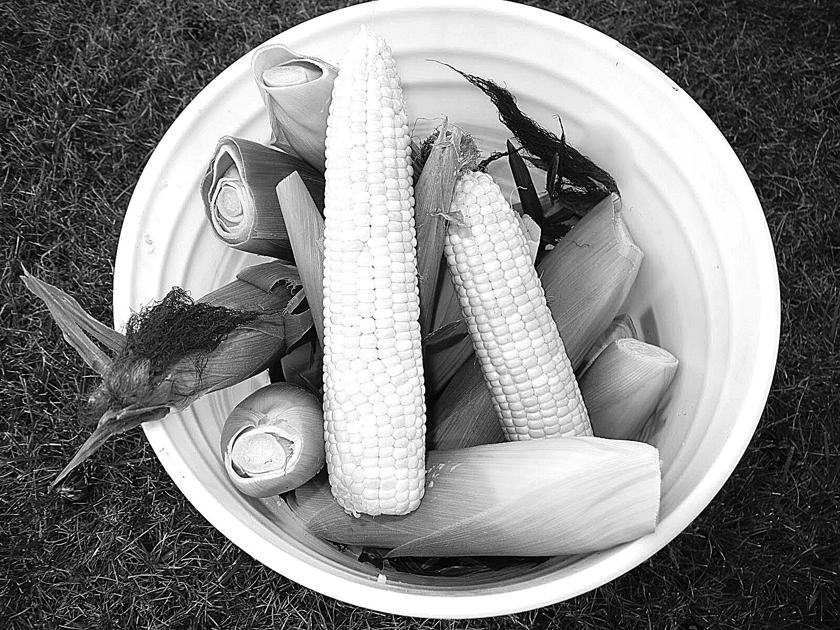
An ear of sweet corn is everything good about summer here in Iowa. Sure, you can have an ear of sweetcorn out of season from a supermarket in the dead of winter thanks to long distance food. But it will travel perhaps 1,500 miles to get to your plate.
The real treat is sweet corn you grow in a kitchen garden or buy fresh from a local vendor. The distance from where it was grown and where it is served can often be measured in foot steps not odometers miles.
I am no “corn whisperer” by any means but once an ear of sweet corn is off the stalk its flavor is at the whim of time and distance. The clock is ticking once sweet corn is harvested because the sugar content, the sweetness of sweet corn, begins turning to starch.
Sweet corn is one of the six members of the corn family: sweet corn, dent corn, flint corn, pod corn, popcorn and flour corn.
Every state, even Alaska and parts of Canada, grows sweetcorn though, as much corn as Iowa produces, we don’t figure in the commercial production of sweet corn. Minnesota leads the nation in commercial acreage followed by Washington, Wisconsin, California and Florida. Even so, the amount of sweet corn and pop corn consumed in the United States accounts for about 1 percent of all corn grown.
I have eaten fresh sweet corn on a farm deep in the woods north of Lake Superior in northern Ontario that was as good as anything grown here in Jackson County. Thanks to plant genetic manipulation and cold tolerance during germination and emergence sweet corn can thrive in some challenging conditions.
You can thank Native Americans for this delicious gift to mankind. Likely a naturally occurring mutation of an open pollinated dent corn strain, the Iroquois called it “papoon” and gave some of the seed to European settlers. The first record of this sweeter tasting corn dates back to 1779. This new type of corn was first listed by an American seedsman in 1828 according to Cornell Cooperative Extension’s The Heirloom Vegetable Garden. Almost all the early varieties were white kernel. By the mid-1800s seedsmen were selling open pollinated sweet corn with names like “Country Gentleman,” and “Stowell’s Evergreen.” By 1880 sweet corn was well established as an important item in the diet.
It wasn’t until 1902 when Golden Bantam was introduced that yellow sweet corn was considered fit to eat. They were not really all that sweet but no one could imagine how this variant of Zea maize would become the super sweet star of summer foods.
Dr. John Laughnan, botany professor and corn geneticist at the University of Illinois was the first to suggest two sweet corn genes, one responsible for pigmentation and the other, known as “sh2” which showed unique properties could influence sweetness. Laughnan’s 1953 report noted the endosperm of the sh2 kernels stored less starch and from four to ten times more sugar. This research and additional discoveries by Dr. “Dusty” Rhodes at University of Illinois, led to the first foundation seeds of super sweet Illini Chief and other subsequent sweet corn varieties.
We’re not alone in our love of sweetcorn. It is grown around the world. In South America sweetcorn is often served with beans, each complements the other in flavor and nutritional value to make a more complete entree. Street vendors sell it in Indonesia.
Sweet corn is much like its other corn relatives when it comes to the nitty gritty details of growing a crop. Here in eastern Iowa varieties that produce a roasting ear will need 65-90 days until harvest.
For the last seven years now this remarkable plant, a grass we treat like a vegetable, has organized my summers, and those of fellow Andrew Lions Club members. Thanks to a growing line of repeat customers we’ve turned sweet corn in to a community project of sorts. We grow it, you eat it, we donate the proceeds to kids trying to better themselves with more schooling.
Sweet corn has generated $18,000 in scholarship grants to 25 deserving young people. It won’t put them through school by any means, but it is a boost, a sign this community wants them to succeed.
We’ve had people show up at the corn patches to help pick ears. Out of the goodness of their hearts local farmers and suppliers have donated crop inputs, provided equipment. Andrew’s convenience store owner and staff make space for us to hawk our corn, supply us with electricity to keep it cool.
In a quiet way sweet corn has also become a vehicle to connect us with others.
The taste of an ear of sweet corn, a tomato fresh from the garden, a BLT, a glass of iced tea and then peach pie from the oven, there is hope even when times are scary. It’s comfort food for a summer like none we’ve witnessed in decades.
Go ahead and eat more sweet corn, we’ll grow more!
August 19, 2020 at 12:00PM
https://ift.tt/2Yfwdbt
Sweet Corn: It's summer on a plate served with a side of happy memories - bellevueheraldleader.com
https://ift.tt/3gguREe
Corn

No comments:
Post a Comment